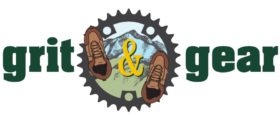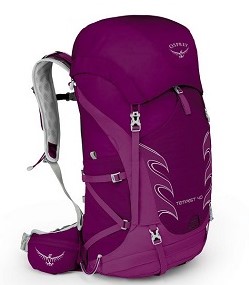When it comes to backpacks, the optimal number to have is n+1. I say this not to promote excessive consumerism and emotional buying, but because our hiking distances and objectives range from a two-hour day hike in a local state park or forest to a two-day trek on the Superior Hiking Trail to a two-month slog on the Appalachian Trail. The Osprey Tempest 40 ($160) is the pack that hits the sweet spot for long day hikes and two-day treks.
Women-specific Design
So much of the outdoor industry’s spin on women-specific gear feels like a pervasive marketing gimmick to “reach women” and “engage them in the outdoors”. Apparently, swirls, pastel colors and cute graphics are thought to be the clincher that seals the deal. Wrong!
When it comes to backpacks (and bike saddles), there is some validity. Compared to men, women tend have narrower shoulders, shorter torso lengths, and different hips (for some archaic, barbaric, biological practice called “child bearing”). It makes sense that backpack design is sensitive to that. But are narrow shoulders, shorter torsos and hip size limited to only a woman’s body type? No. There are lots of scrawny dudes and broad-built women out there. That being said, the Osprey Tempest 40 looks unisex in its design (until you put it on) and is mercifully devoid of swirls, pastel colors and floral graphics.
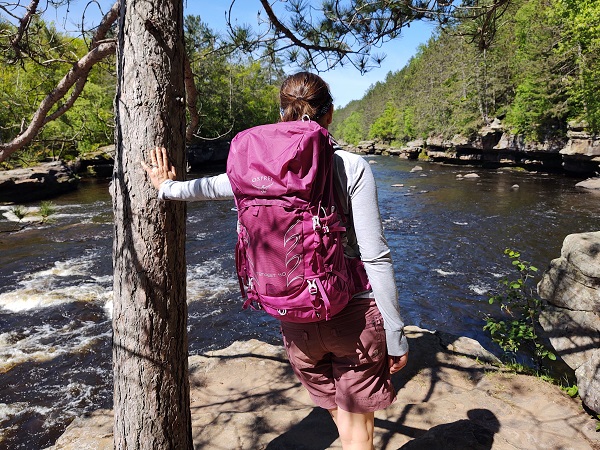
40 Liters Holds more than you Think
Until recently, I’ve been using the Osprey Tempest 40 as a long dayhike pack and summit pack. Let me tell you that it works amazingly well for that. However, it’s like owning a Porsche 911 and never exceeding 55 mph. It can do so much more! Like when I took it on a two-day solo hike on the Superior Hiking Trail for a 19-mile hike between Lutsen and Grand Marais.
Could I really carry enough gear in the 40 liters that make up the Osprey Tempest 40?
Weight
Fully empty, the Osprey Tempest 40 weighs 2.4 lbs. When it’s all packed for a two-day solo hike, with the basic necessities, it weighs in at…
Top-loading design
Front-loading vs top-loading will almost always be a subject for debate, even among the best of friends. There’s merit to each depending on the objective of the mission. But top-loading design, at least for me, means lighter weight and fewer failure points. We’re not talking five pounds of weight, more like mere ounces. But when you’re on an all-day hike or a multi-day thru hike, and you’re carrying a sleeping bag, tent, food, water, camp stove, etc, the extra ounces add up.
Zippers can also break. Should that happen when you’re days from civilization, whaddya do when all your gear tumbles out? Or the zipper jams to the point where you need the jaws of life and you don’t have a pair? For the record, the pro-front-loaders dis the pro-top-loaders because front-loaders are easy to organize and access that dry pair of socks smushed at the bottom of the pack without unpacking the entire pack to find. But us top-loaders mitigate this by packing with intent: Dry socks are packed at the very top.
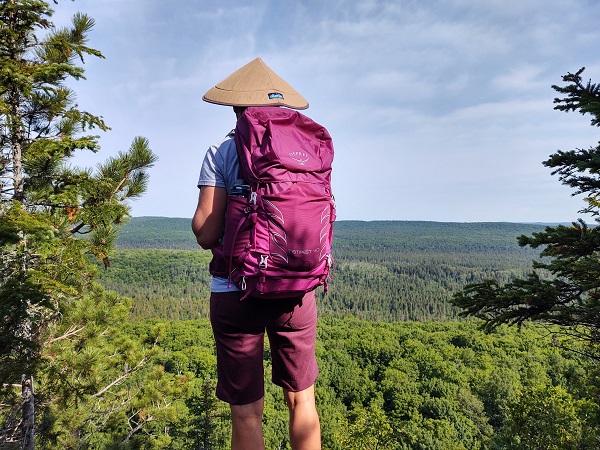
Outstanding Organization
Floating Removable Top Lid
Like its bigger multi-day, top-loading sisters, the Osprey Aura AG 65 and Osprey Xena 85 (of which I have older versions), the Osprey Tempest has a floating removable top lid with exterior and interior zippered pockets. This where I stashed the items that I would need quick access to, like first aid kit, dry socks, phone, trail snacks, sunblock, rain jacket, rain pants, bug spray, etc.
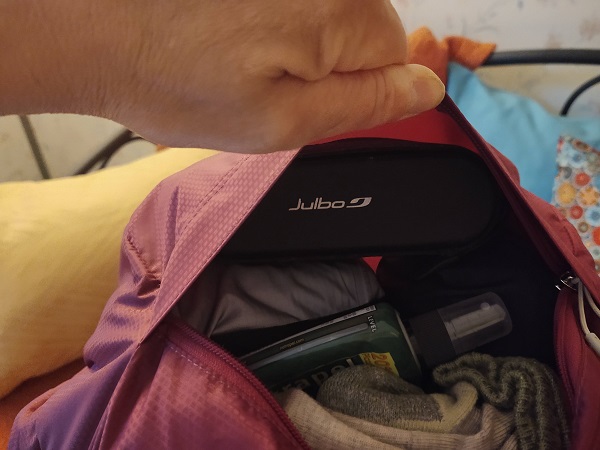
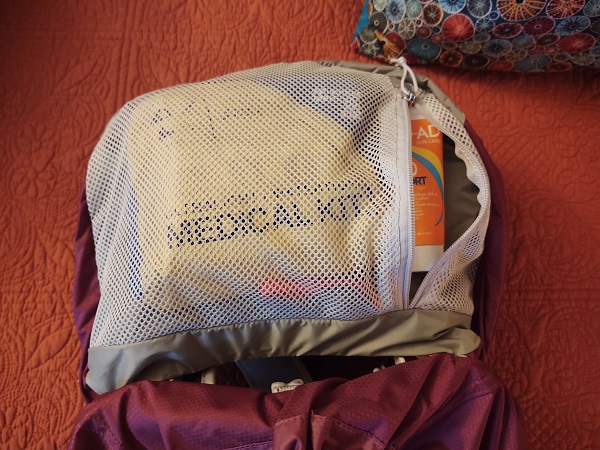
Stretch Side Pockets
Another hold-over from the big sisters Aura and Xena are two stretch side pockets. I rely on these for holding a trail map, smartphone and, like any reasonable human hiker, a flask of brandy.
For a pack’s side pockets to be of value to a hiker relies on their position and depth. If they’re positioned in a way that you can’t easily access them while wearing your pack, or they’re so shallow that your contents fall out, they’re of limited use on a hike.
The Osprey Tempest kills it with the depth of the pockets. They’re deep, cavernous and my map and smartphone have no way of escaping unaided. I liked this. However, the angle of those deep pockets is straight up/down making it harder to access my map and phone while wearing the pack. I can do it, I just don’t always get it on the first try and it’s never pretty.
Main Compartment
The Tempest has a 40L main compartment. For an overnight hike on the Superior Hiking Trail, it held food for four meals, pillow, sleeping pad, change of skivvies, long-sleeve pullover, sleeping shirt/shorts, small ditty bag, fire-making supplies, camp stove, bowl, fork, spoon, trashbag, water purifier, biodegradable soap, camp towel, bear line, headlamp, book in addition to a handful of other trail necessities.
A convenient zipper located at the bottom of the pack allows you to gain access to items stashed in the pack first. In my case, it was the bear line and my sleeping bag. Osprey calls this zipper access the “sleeping bag compartment” but it isn’t an isolated compartment. Personally, I’d be happy to see this zipper go because it just adds extra weight.
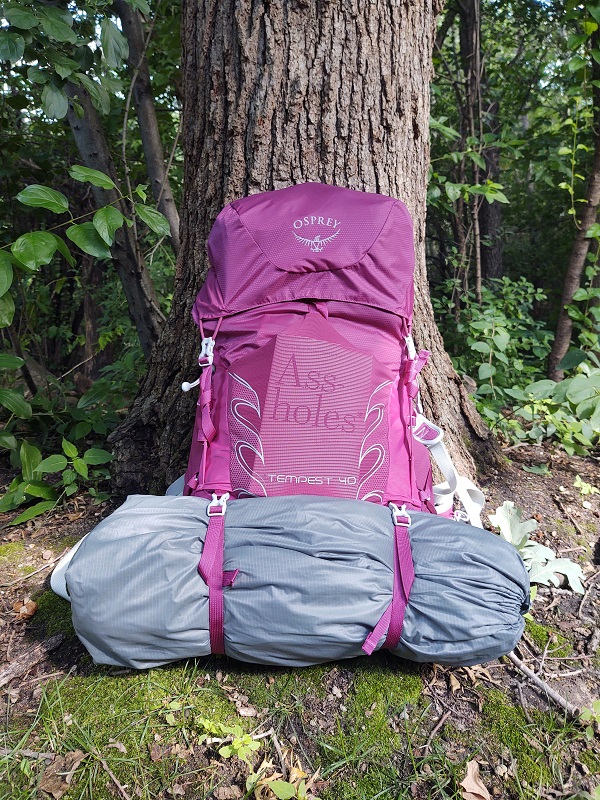
Hip Belt Pockets
The Osprey Tempest 40 has two zippered mesh pockets on the hip belt. What I carry in these are items like lip balm, Swiss Army Knife and, like any conscientious person these days, a face mask. I encountered a few other hikers on the Superior Hiking Trail and that always invites opportunity for light conversation: Where did you start? Where are you hiking to? Are you from the Cities? Wow, love those colorful hiking socks! Because I’m not 100% certain I’m COVID19-free, I wear a mask to protect others.
Shoulder Straps
This is one of the spots where a women’s-specific design is appreciated. The Tempest 40’s straps are made with a soft foam that is not too thick, not to thin and are curved to create a nice and comfortable fit for a woman’s shoulder and chest. They’re also perforated to allow for ventilation.
Backpanel
The Airscape backpanel is unique in that it is comprised of a lightweight mesh attached to a backpanel of raised foam ridges in the design of an “accordion”. The shape of the ridges, coupled with the mesh, ensure good airflow between the pack and your back.
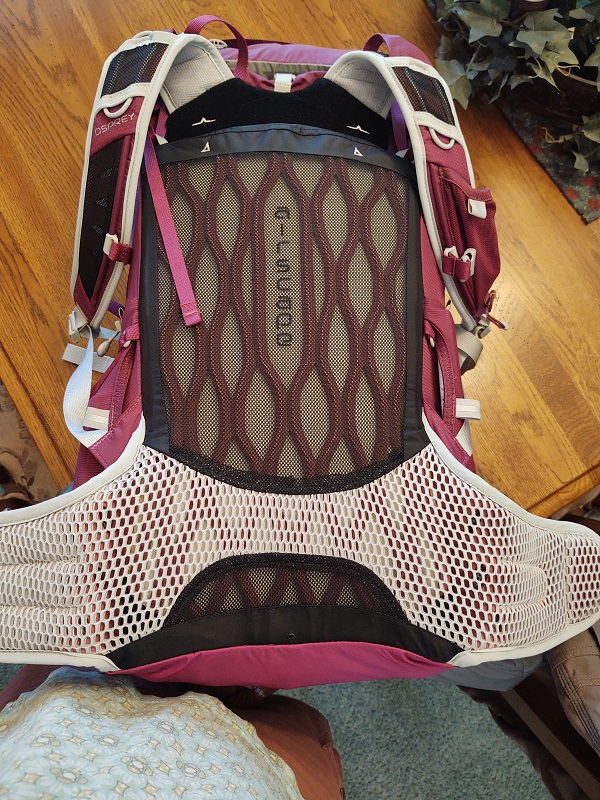
Hip Belt
The hipbelt is made with a soft foam that conforms to hipbones and allows for a comfortable load transfer. After four months of hiking with this pack carry varying weights, the hike that I noticed the comfort the most was on my two-day solo trek on the Superior Hiking Trail when the Tempest was loaded with 22.8lbs of gear and a full bladder of water. As with any pack it takes some finagling and tweaking of the shoulder straps and load balancer straps to find the sweet spot of comfort. Once I found it, the pack’s load was always well-dispersed and comfortable to carry for 8-10 mile days.
Size is Accurate
I have a 17.25 inch torso so I went with the S/M size per the Tempest’s official sizing for S/M (17”-20″). It was the right size. That means I have plenty of room to grow! If you ever wonder how to measure your torso length, check out this neat little vid from Backpacker mag.
What Could be Improved
As with most Osprey products, there isn’t much to improve upon. But I did find two things!
Kill the “Sleeping Bag Compartment”
It’s not a separate compartment so why add the extra weight and potential failure point of a zipper?
Add an Integrated Raincover
C’mon, Osprey. You’re really going to make me carry an extra rain cover??
Conclusion/Final Thoughts
To summarize the Osprey Tempest 40 in one word is easy: Amazing! It’s small enough to be a solid day pack for short or day-long hikes but it’s big enough for a two-day, self-supported solo hike, carrying everything you need, including tent, sleeping bag, camp pad, water and food. It’s a pack for a slow, meandering hike. It’s a pack for fast-hiking.
All the features are thoughtful, purposeful. There is nothing on the pack that is superfluous. In addition to the biggies that I listed earlier in this review, it also has stow-on-the-go trekking pole attachment system, a total of eight pockets situated in the most useful places, ice attachment loops (if you’re into that), emergency whistle on the sternum strap and the most wonderful feature of all? Osprey’s Lifetime Warranty.
